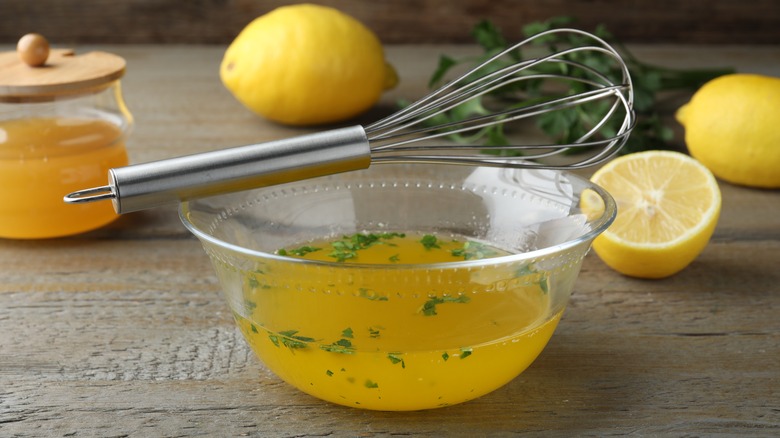Rachael Ray Simplifies Salad Dressing With A Little Bit Of Math
We may receive a commission on purchases made from links.
Ready to ditch store-bought bottles and whip up a batch of delicious homemade salad dressing? Then forget the complicated recipes and embrace Rachael Ray's simple formula for a quick and easy vinaigrette. While there's a smidge of math involved, it's not as complicated as you might think. These calculations will be quick and painless — they don't even require measuring cups or spoons if you're in a pinch, offering consistent results every time.
Let's get mixing. For every four portions of salad, measure out 1.5 tablespoons of acid (such as vinegar) and about ⅓ to ½ cups of fat (Ray prefers olive oil). Start by adding your acid into the base of a mixing bowl with a pinch of salt and pepper to taste. Then, slowly pour the fat into the mixture while whisking vigorously back and forth. This motion emulsifies the dressing, bringing hard-to-bind ingredients together to create a smooth texture and mouthfeel.
While this will give you a specific yield and does require at least a couple tools to measure out, you can further simplify it by thinking in parts — one part acid to three parts fat. You can stick to this ratio no matter how big or small your batch is, making it ideal for large batches and single portions. You can measure with a shot glass, soup spoon, water bottle cap, or anything else you find in the kitchen, as long as you stick to this golden vinaigrette ratio.
Flavor boosts and customizations for your homemade dressing
Salad dressing is always comprised of an acid and a fat, which is why they're the main ingredients in Rachael Ray's concoction. Salad-friendly acidic bases include lemon juice, lime juice, and various vinegars — you can even add a splash of pickle juice to your dressing. Acids impart tart flavors while also adding natural preservatives, serving a dual purpose. Fats add a lot of flavor to the party — common varieties include olive oil, avocado oil, sesame seed oil, and grapeseed oil. Other fat-forward foods can be used, too — think whipped avocado, nut butter, or Greek yogurt.
Homemade blends can be endlessly riffed on, delivering exciting flavor combinations. Ray suggests adding a dash of honey to up the sweetness or a tablespoon of Dijon mustard for a kick. Grated Pecorino and Parmesan cheeses are best for rich and salty notes. Add leftover herbs or blended, overripe fruit to your dressing to help reduce fridge waste while adding flavor. Finely diced shallots and garlic can also intensify the final product.
Best of all, storing your DIY vinaigrette is just as simple as making it — all you need is a sealable container. You can use a mason jar or storage container you've got on hand, or you could opt for something like Whiskware's leak-proof shaker bottle that makes it easy to stir and pour the mixture onto your leafy greens. Store your dressings in the fridge for between four days and two weeks. Have a surplus? Use extra portions as a condiment, marinade, or dipping sauce to add culinary flair to any dish.


